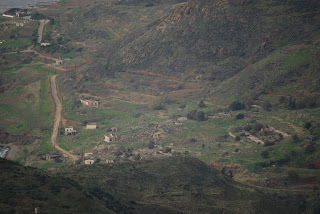Last Sunday we headed west to enjoy the northwest coast of the island along Morphou Bay and the Akamas Peninsula, which is a route that was made possible only a few months ago after the border checkpoint at Kato Pyrgos opened.
MORPHOU
We started our journey in the citrus producing capital of Cyprus, Morphou. There’s not much to see in the town, but surrounding the built up area is grove after grove of orange, lemon, and grapefruit trees. I posted a picture from one of the groves in my last post.
SOLOI
After passing the former American-run Cyprus Mining Corporation site, we found the driveway-like gravel path entrance to the archaeological site of the ancient village of Soloi. This almost 3000 year old site was one of the ancient city kingdoms of Cyprus. The main monument on the site is the ruined 4th century basilica. Its massive proportions (one the width and length are visible today) and mosaics of geometrical patterns and wildlife are extremely impressive. Unfortunately, the entire basilica is covered by a terribly ugly roof that obstructs much of the appreciation of the site (although it does protect from weather damage). Maybe a more appropriate intervention would have been to create a roof that generally represents the height and form of the structure, which must be known based on the toppled column sizes and other evidence. I assume this roof was put on some time ago before the more contemporary restoration project was undertaken by the UNDP.


 |
The roof also seems to have been installed with little care for the importance of the 1500 year old masonry as the steel supports of the roof at the corners are placed on concrete footings that have been poured to the foundations. |
The other main attraction at the site is the Roman Theater. The theater was largely demolished by the British in the late 19th century for Port Said in Egypt and was rebuilt later. At the top of the theater it was interesting to consider how magnificent of a city Soloi might have been to live in 1500 years ago. One can imagine the village surrounding the agora (or marketplace) which is located only a few dozen feet from a massive basilica. Up the slope a short walk was a magnificent theater that seated up to 4000 people and overlooked Morphou Bay as its backdrop. Turning away from the stage are rolling foothills leading up to the Troodos Mountains.
Heading away from the bay in the direction of the foothills we noticed another settlement, which was undoubtedly an archaeological dig site at some point in the past but has since been overgrown. Not far from there was farm land that had a large sheep pasture as you can see below.
KATO PYRGOS CHECKPOINT
From Soloi, we continued to the west through the new checkpoint at Kato Pyrgos. Kato Pyrgos is a village in the Greek Cypriot community that, until the recent checkpoint opening, was about as far off the beaten path as you could get in Cyprus. It will be interesting to see how the coastal town will develop over the next few years as tourists begin to visit it more often.
KOKKINA
Our scenic drive continued to the west along a winding mountain pass where the Troodos Mountains meet the sea. At multiple locations along that road there are various Cypriot National Guard and UN stations protecting a unique town in Cyprus. The village turned “exclave” known as Kokkina to the Greek Cypriots and Erenkoy to the Turkish Cypriots is another interesting story in the Cyprus Problem. As I understand it, during the struggle in the summer of 1974 the Greek military junta attempted to push this small village of Turkish Cypriots into the sea. The village was suspected to be a port of Turkish military and arms transport. Following a struggle pitting the Turkish Cypriot citizens and Turkish military personnel against the Greek military junta (known as EOKA B), the Turkish air force responded by bombing and napalming the site heavily. Many casualties and grave injuries resulted from the struggle. Today, the small village is surrounded by a separate Buffer Zone that lies south of the main Buffer Zone that divides the island between north and south. We were told that the village is basically uninhabited today except for the Turkish military personnel that guard it. The drive through Kokkina would cut at least 20 minutes off the travel time required to drive around the 3 km Buffer Zone.
 |
| Ruins of the former village of Kokkina |
After driving for a while longer, we decided to turn back from our intended destination of the Akamas for concern of the lack of daylight we had left. We intend to return when the weather is nicer to take advantage of the uninhabited beaches.
On our way back we stopped to photograph the mountain goats of the Troodos that were roaming the hillside.
Finally, we drove as far northeast as we could along the coast to find a spot to watch the sun set. The rocky coastline we found produced a warm glow as the sun went down which made for a perfect photo opportunity. As rain began to fall, a rainbow appeared opposite the sunset, while the area in between was blue sky with white clouds.




